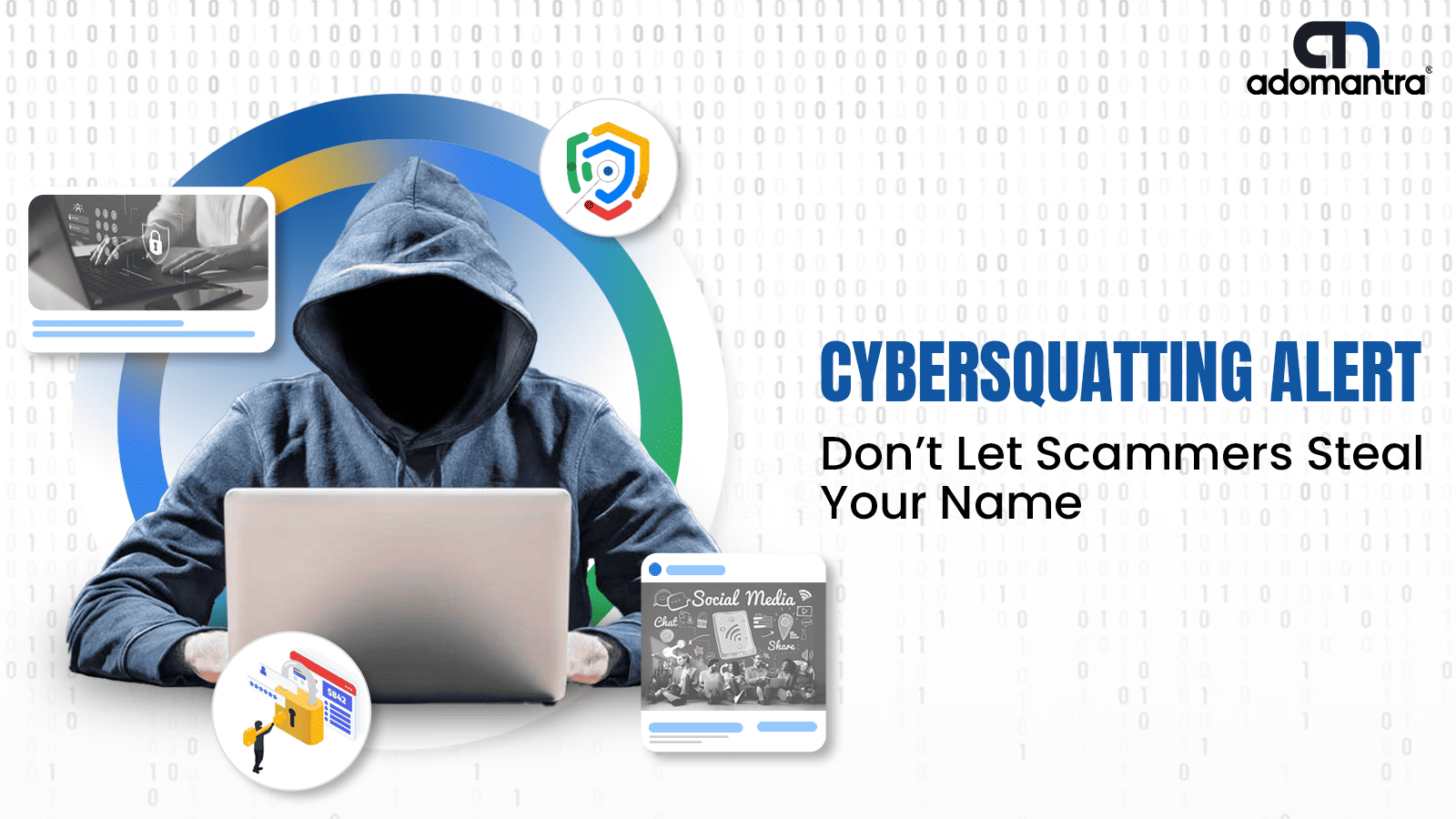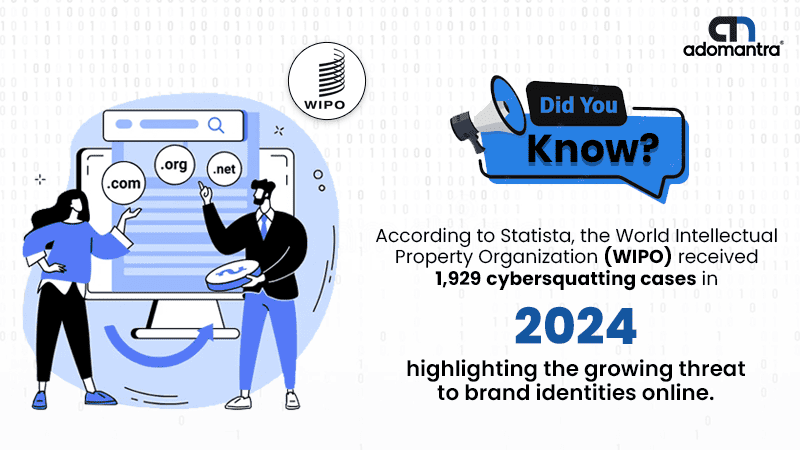
Cybersquatting - A Digital Threat Every Business Should Know
In today’s digital economy, domain names are more than just web addresses. They’re brand assets. And with the rising value of online presence, a threat called cybersquatting is making waves.
If you’ve never heard of it before, you’re not alone. Many businesses only learn about it after it affects them. Let’s break down what it means, how it works, and what your business can do to stay safe!
What Is Cybersquatting?
Cybersquatting refers to registering or using a domain name with the intent to profit from someone else’s trademark or brand name. It’s usually done in bad faith. The goal is simple—buy a domain that closely matches a known brand and wait for the rightful owner to pay a high price for it.
This isn’t a small-time issue. According to the World Intellectual Property Organization (WIPO), domain disputes under their rules grew by 11% in 2022, showing that more businesses are being targeted each year.

Image source - https://www.wipo.int/amc/en/domains/caseload.html
Types of Cybersquatting You Should Know
There’s more than one way cybersquatters operate. Here are the most common types of cybersquatting:
- Typo-squatting: Buying domains with common misspellings. Example: gogle.com instead of google.com.
- Look-alike domains: Registering domains that look visually similar to original ones. For instance, amaz0n.com with a zero instead of an “o.”
- Generic brand targeting: Registering a domain before a business officially launches. Squatters watch trademark filings to get ahead.
- Country-code abuse: Buying a local version of a global domain (like brandname.in) to confuse users or extract money from regional operations.
These tricks often lead to phishing, redirecting traffic, or reputational harm.
Real-World Cybersquatting Examples
1. Amul
Amul, one of India's biggest dairy brands, was targeted when scammers registered domains like amuldistributor.com to run fake distributor schemes and demand payments. Amul issued warnings and took legal action.
2. Popular Tech & Banking Brands
Palo Alto Networks found fake domains like walrmart44.com and secure-wellsfargo.org being used to steal personal information, spread malware, and run prize scams.
3. Fox News
Fox News sued owners of xofnews.com and foxnews-entertainment.com for copying their website design and promoting fake weight-loss products, misleading users.
4. Madonna
Pop star Madonna faced cybersquatting when someone registered madonna.com without permission. She filed a case with WIPO and won, gaining control of the domain in 2000.
5. PETA
A cybersquatter created peta.com mocking PETA’s mission by calling it "People Eating Tasty Animals." PETA sued and won the domain, which now redirects to their official site.
6. Mitsubishi and Microsoft
Critics launched gripe sites like mitsubishisucks.com and microsoftsucks.org to air complaints. These led to legal challenges and antivirus warnings for visitors.
7. Business Insider
A fake article under foxworldnews.today mimicked Business Insider, promoting a scam brain supplement and linking to an affiliate marketing site.
8. Hazelden Betty Ford Foundation
Germany’s My Way Betty Ford Klinik used a confusingly similar name and domain (mywaybettyford.de) to the U.S.-based foundation, leading to a cybersquatting lawsuit.
Cybersquatting Laws That Protect Brands
The internet may feel lawless at times, but there are strong cybersquatting laws in place. The most important one is the Anti-Cybersquatting Protection Act (ACPA) in the United States. It was passed in 1999 to help trademark owners fight domain name abuse.
This law gives companies the right to sue a domain holder in federal court if they prove:
- The domain is identical or confusingly similar to their trademark.
- The registrant has no rights or legitimate interests in the domain.
- The domain was registered in bad faith.
If successful, the business can gain ownership of the domain and may also receive damages up to $100,000 per domain.
What Counts As a Cybersquatting Domain?
A cybersquatting domain typically contains:
- A registered trademark or brand name.
- A misspelled version of a known domain.
- Terms that mimic a company’s product or slogan.
- Names that are confusing or misleading for users.
These domains are often held hostage. The registrant may demand money, redirect visitors to competitors, or place ads to profit from traffic meant for the brand.
Notable Cybersquatting Cases in Recent Years

WIPO and ICANN handle thousands of cybersquatting cases each year. For example, Meta Platforms (formerly Facebook) filed 155 domain disputes in 2022 alone. In most cases, they won and recovered the domains without having to pay off the squatters.
Other companies like Microsoft, Google, and Nike actively monitor domain registrations to catch threats early.
The lesson? Cybersquatting can hit brands of any size, and the legal fight can take months if you’re not prepared.
Cybersquatting Legal Issues Businesses Face
Dealing with cybersquatting legal issues can be complex. You might have to prove the bad faith of the registrant, which isn’t always obvious. In some cases, domains are held anonymously through privacy protection services.
Businesses also struggle with international disputes. While ACPA covers US domains, cases involving foreign registrants or different country-code domains (.uk, .in, etc.) fall under different rules.
That’s why many companies turn to the Uniform Domain Name Dispute Resolution Policy (UDRP) process, which is global and faster than court battles.
How to Report Cybersquatting and Protect Your Brand
Caught a fake domain using your brand? Here’s how to report cybersquatting:
- Check domain ownership on sites like Whois.com.
- Contact the domain holder, if possible, and express your trademark rights.
- File a complaint with ICANN or use the UDRP procedure.
- Use the ACPA if the domain is under a U.S. registrar.
You can also hire IP attorneys or cybersecurity firms that specialize in domain disputes. Many offer domain monitoring services to alert you when similar domains get registered.
Final Thoughts on Cybersquatting in Business
For B2B companies, cybersquatting isn’t just a tech issue—it’s a brand safety issue. A hijacked domain can damage trust, drive traffic away, or even expose customers to scams.
If you’re launching a new product, registering domain names early is a smart move. Buy not just the .com, but also variations (.net, .co, etc.) and common misspellings. Use a trademark attorney to secure your brand legally and digitally.
Want to safeguard your brand from cybersquatting? Adomantra, a digital advertising company, offers proactive digital brand data protection and domain monitoring strategies tailored for B2B. Stay protected while you grow online.







